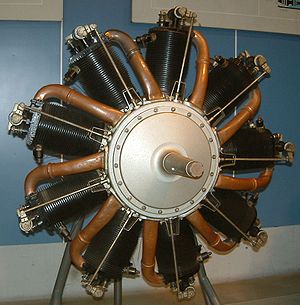Le Rhône
| Le Rhône | |
|---|---|
 |
|
| 80 hp Le Rhône Model 9C, showing forward-mounted induction piping | |
| Type | Rotary engine |
| Manufacturer | Gnome et Rhône |
| First run | 1910 |
Le Rhône was the name given to a series of popular rotary aircraft engines produced in France by Société des Moteurs Le Rhône and the successor company of Gnome et Rhône. They powered a number of military aircraft types of the First World War. Le Rhône engines were also produced under license worldwide.
Although not powerful (the largest wartime version produced 130 horsepower (97 kW)), they were dependable rotary engines. The Le Rhône 9 was a development of the Le Rhône 7, a seven-cylinder design. Examples of nine-cylinder Le Rhône rotary engines are on public display in aviation museums with several remaining airworthy, powering vintage aircraft types.
The copper induction tubes had their crankcase ends located in different places on the 80 and 110 horsepower (60 and 82 kW) versions – the 80 hp versions had them entering the crankcase in a location forward of the vertical centerline of each cylinder, while the 110 hp version had them located behind the cylinder's centerline. This resulted in the 80 hp version's intake plumbing being "fully visible" from the front, while the 110 hp version had the lower ends of its intake tubes seemingly "hidden" behind the cylinders.
A complicated slipper bearing system was used in the Le Rhône engine. The master rod was of a split-type, which permitted assembly of the connecting rods. It also employed three concentric grooves, designed to accept slipper bearings from the other cylinders. The other connecting rods used inner-end bronze shoes, which were shaped to fit in the grooves. The master rod was numbered as number one and the shoes of numbers two, five and eight rode in the outer groove, the shoes of three, six and nine in the middle groove and four and seven in the inner groove. Although this system was complex, the Le Rhône engines worked very well.
The Le Rhône engines used an unconventional valve actuation system, with a single centrally-pivoting rocker arm moving the exhaust valve and the intake valve. When the arm moved down it opened the intake valve and when it moved up it opened the exhaust value. To make this system work a two-way push-pull rod was fitted, instead of the more conventional one-way pushrod. This feature required the cam followers to incorporate a positive action, a function designed in by using a combination of links and levers. This design prevented valve overlap and so limited power output, but as the engine structure and cooling arrangements would not have been adequate at a higher power output this should not be considered a significant design fault.
...
Wikipedia
